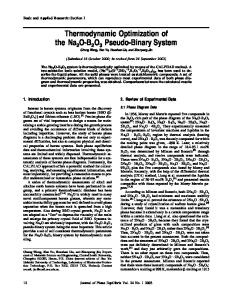Critical Evaluation and Thermodynamic Optimization of the Li 2 O-Al 2 O 3 and Li 2 O-MgO-Al 2 O 3 Systems
- PDF / 3,526,519 Bytes
- 28 Pages / 593.972 x 792 pts Page_size
- 50 Downloads / 404 Views
INTRODUCTION
LITHIUM oxide compounds of the Li2O-Al2O3 and Li2O-MgO-Al2O3 systems are important lithium ceramic materials for applications in tritium breeder materials,[1–3] solid-state electrolytes,[4–8] Li batteries,[9–13] matrix materials in fuel cells,[14–17] mold flux for advanced high-strength steel (AHSS) castings,[18–22] and carbon dioxide absorbents.[23,24] Lithium oxide-containing glass is also used as waste disposal glass for high-level nuclear waste.[25] To better control the material production and its application under various environments, thermodynamic information such as the phase diagram and chemical reactivity is essential. However, the thermodynamic properties and phase equilibria of the Li2O-MgO-Al2O3 system have not been fully understood yet. In the thermodynamic ‘‘optimization’’ of a system, all available thermodynamic property and phase equilibrium data are evaluated critically and simultaneously to obtain a set of Gibbs energy expressions of all phases as functions of temperature and composition. The resultant CALculation of PHAse Diagram (CALPHAD)-type thermodynamic database containing the Gibbs energy functions can be accessed by a thermodynamic software
BIKRAM KONAR is with the Department of Mining and Materials Engineering, McGill University, 3610 University Street, Montreal, QC, H3A 0C5, Canada. MARIE-ALINE VAN ENDE and IN-HO JUNG are with the Department of Materials Science and Engineering, Research Institute of Advanced Materials (RIAM), Seoul National University, 1 Gwanak-ro, Gwanak-gu, Seoul, 08826, South Korea. Contact e-mail: [email protected] Manuscript submitted July 31, 2017.
METALLURGICAL AND MATERIALS TRANSACTIONS B
with a Gibbs energy minimization routine to calculate complex phase diagrams and chemical reactions as well as thermodynamic properties. Several first principles calculations and molecular dynamics simulations[4,26–30] were carried out to understand the crystallographic, electronic, mechanical, and thermodynamic properties of lithium aluminates and their interactions with MgAl2O4 spinel and other oxides. The Li2O-Al2O3 system was thermodynamically assessed by Byker et al.,[31] Cooke and Plante,[32] and Kulkarni et al.[25] Byker et al.[31] described the liquid phase using the Bragg–Williams random mixing (BWRM) model. However, an accurate phase diagram and thermodynamic properties of the system were unavailable at the time of their study. Later, Cooke and Plante[32] conducted an assessment primarily based on their own experimental phase diagram data. Recent thermodynamic optimization by Kulkarni et al.[25] employed the associate model to describe the liquid solution. Several associate species, LiAlO2, Li3AlO3, and LiAl5O8 together with Li2O and Al2O3, were used to reproduce the phase diagram. However, Kulkarni et al.[25] neglected many thermodynamic data of solid phases available in the literature and also neglected the LiAl11O17 compound. In summary, no comprehensive and accurate thermodynamic modeling study of the Li2O-Al2O3 system has yet been conducted. I
Data Loading...











